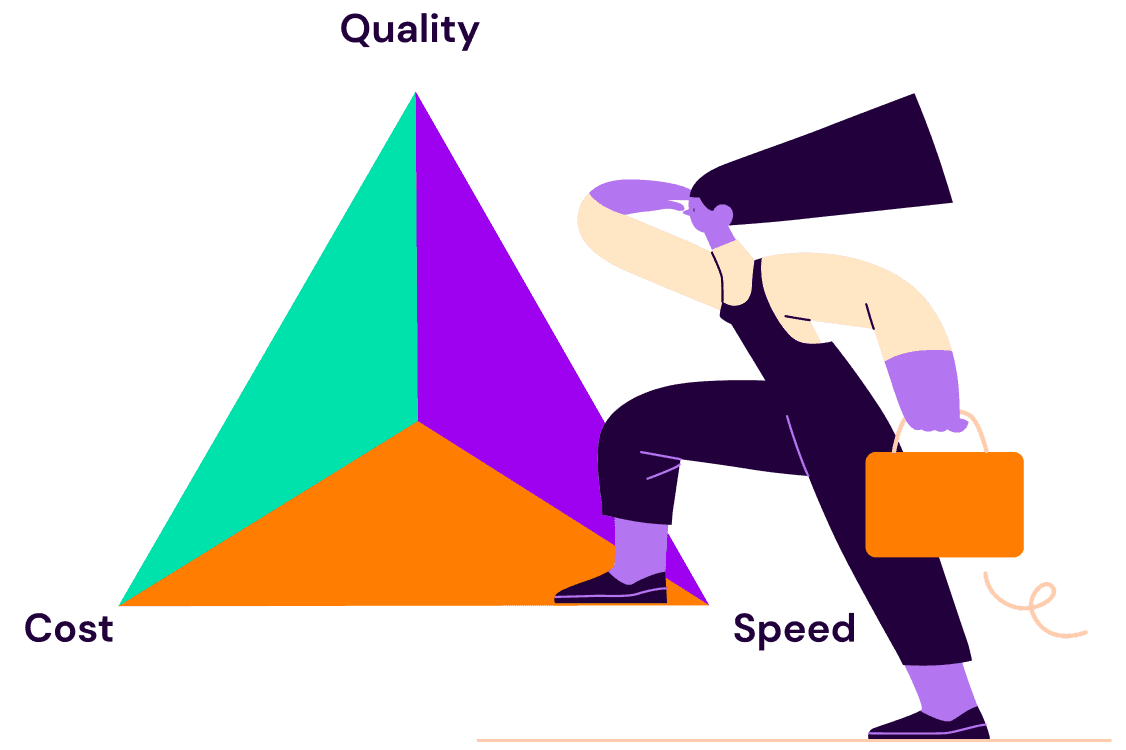
Back to blogs

How to Get Started with Skills: An Executive Workshop with Josh Bersin
Team SeekOut recently held an executive roundtable for talent leaders with global analyst Josh Bersin to discuss how to get started on the path to becoming a skills-based organization.
Josh set the stage with great context to the evolving skills conversation and what organizations are doing to address talent problems with a skills-centric approach. Then, we workshopped three scenarios based on attendees’ real-life challenges and got feedback on how leaders can start making an impact.
Here’s a summary of what Josh shared with us.
Everyone’s talking about skills—how did we get here?

“Some companies will continue to grow through hiring, but it's getting harder to do as skills become more competitive.”
We're in the middle of a transformation from a job-based architecture in businesses to a people-based architecture. For most companies, the traditional, functional structures—with hierarchical job titles, levels, descriptions and competencies—have become too difficult to manage given today’s rate of change. In our new world, we have new jobs, skills, projects, initiatives, and new technologies and tools. Companies are considering whether they have the right people and capabilities to do new kinds of work.
There’s also a very tight labor market. Baby boomers are retiring and in many populations around the globe, people are having fewer children as their numbers of employees have flatlined. Basically, this means we're growing our companies through productivity, rather than through people. Some companies will continue to grow through hiring, but it's getting harder to do as skills become more competitive—you must pay more to get rare or high-demand skills. So internal development is another way to address this issue.
Additionally, organizations have become flatter. Leaders want people to feel more comfortable working on different teams and projects, and this also contributes to this movement toward skills-based organizations.
How is the “skills-based org” conversation evolving?
In a more skills-based world, we associate skills with a person, not a job. And this isn’t a new idea. Maybe 10 years ago, learning experience vendors began making training materials more widely available, and by indexing what people were searching for, they started to understand what skills people had and were looking for. What’s new today is the application of big data and AI.
Companies like SeekOut and others started applying this approach to recruiting—they realized that recruiting based on specific job titles or experience would limit organizations’ talent pools. Using AI, you can identify and infer skills that were not obvious or represented in a job title or somebody's prior experience, education, connections, and so on.
Then came the application of skills in the talent marketplace. If you’re using skills for recruiting and internal development, what about internal mobility? You might have somebody who's bored in their current role or working at a job where you’re about to lay them off, and they might be a perfect fit elsewhere.
Next, big HCM vendors announced cloud-based skills products. And companies didn’t want a bunch of specialized systems to manage skills, so they thought, “Let's just build a corporate taxonomy and do it for everybody.” And everything came to a grinding halt. Why?
Building a skills taxonomy is a very use case-dependent process. How do you define and label skills? You can buy skills libraries with different sources of data, and you can match them to job titles, but it may not be relevant to your company. We kind of went down this little trough, and now we're coming back up and applying skills to applications.

“Using AI, you can identify and infer skills that were not obvious or represented in a job title or somebody's prior experience, education, connections, and so on.”
Skills is a big, complicated topic. To some degree, there's a belief that if we build the right architecture, these problems will just solve themselves. And that may not be true.
How can organizations get started on their skills journey today?
When Josh works with companies on skills projects, he says “you must fall in love with the problem, not the solution.” If we decide the solution is a skills taxonomy, what’s the problem we’re trying to solve?
The most successful skills projects The Josh Bersin Company has worked on typically span three types of problems:
Underperforming operation: Maybe your salespeople or customer service team are behind, you have high turnover because people are not doing their jobs well, or quality or productivity has declined somewhere within your organization.
A clearly defined skills gap: Say you're a software company, but you don't understand AI, or you're an oil company and you need expertise in lithium and battery technology. In healthcare there's millions of examples of this type of problem. Some agencies that work with the public sector regularly assess the skills they need as part of their planning and procurement process to get ahead of new government contracts.
Longer-term skills transformation: Perhaps companies are merging, growing into new markets, or going after new opportunities. They don't know what they don't know, and they can use tools like SeekOut to find information about the roles and the skills at competitors or peer organizations to get an idea about the evolutions in skills they want to make.
It's all very interesting, strategic stuff—but it’s not sitting around an HR department and trying to figure out what the taxonomy is.

“If we decide the solution is a skills taxonomy, what’s the problem we’re trying to solve?”
Workshopping attendees’ talent challenges
1. Addressing a talent shortage through skills-based hiring
When organizations hire by experience, rather than skills, it has a direct impact on things like diversity. Unfortunately, some leaders are focused on looking for specific industry experience. How can you shift this legacy mindset toward identifying and prioritizing the appropriate skills so that TA can diversify the candidate slate and meet skills requirements?
This is a great example of a common problem, and there are two aspects to addressing it. The first is to use a technology like SeekOut to discover the skills of people you already have in these roles. Identifying the skills profiles of those individuals will immediately move you beyond job titles because then you can take that set of skills and see who else is out there in the market with similar capabilities.
The second piece is the management mindset, whether the leaders will believe the system and take advantage of the information they have. Another part of that is sitting down with the leaders of the groups you're hiring for and talking to them. It can be a workshop or creating what you might consider a “capability council.”
Get with these functional leaders to talk about what skills they think are the most important in these jobs and have a debate. People will have different opinions, but you’ll come out of that workshop with a list of 20 or 30 things that you agree are important. It can help you recognize that you may not need to hire somebody with as much experience as you thought, but that you can develop people in these roles who have the right skills.
The biggest industry that's done this is healthcare. Every clinical healthcare provider is struggling to find people to fill the workload they have for clinical professionals. But they can find people with empathy, people with science backgrounds, and who have other key characteristics, and they can teach them the clinical skills they need.
Finally, the thing about diversity as the driver is that it may or may not be urgent enough to force this kind of a solution to happen. Unfortunately, for many orgs it’s kind of become a “nice to have.” You're going to force managers to potentially hire people who are not what they thought they wanted. Because of that, you need to put business context around the around the problem to justify it.
2. Identifying and closing skills gaps in the workforce
Some industries, like manufacturing, are behind the retirement cliff. People with very specific expertise and experience with unique processes are leaving the company. New hires, even very skilled ones, aren’t ramping up or training quickly enough, which can affect quality or create product delays. How can you move away from antiquated job descriptions and requirements, lean more into transferrable skills, and empower people with the right aptitudes and technical capabilities?
Even if you get an engineer or manufacturing talent who's very skilled, it still takes time to figure out how to do the specific work at your company. You can try to use AI to help capture knowledge and manage your company-specific best practices.
Often, these problems must be solved through a culture of learning where people mentor and teach people, either outside of their regular job or as part of it. You’ll have to incentivize people, maybe encourage senior people to stay an extra year before they retire, or even bring some retirees back to do some coaching.
Sometimes it involves formally assigning domain experts a role to be a capability leader or developer, or a title that rewards them for sharing their knowledge with others. Operational skills, especially internal and external certifications, can be more compliance-oriented—so you’ll want to track who's been through the sessions, who's qualified, and so forth.
3. Investing in a longer-term talent transformation
Your organization has made investments in several systems with skills capabilities, spanning recruiting, HRIS, LMS, etc. Now skills data is all over the place. Where should you put it? How do you organize it and make it more useful? And how do you do this at scale?
This is a very common problem. There's skills technology in every HR tool now. SeekOut has a massive skills data set, others are building skills databases. This is where falling in love with the problem is the most useful. You probably can’t address all the skills in every role you have in the company, thinking that you'll turn this on, and a bunch of people are going to suddenly see new job and development opportunities. It may sort of work, but it won't be perfect.

“In most cases, the most valuable skills data you're going to create is the data you're using for problem-solving—not historical data or the skills taxonomy data.”
There are technologies now that consolidate skills. Some HCM vendors are partnering with the other tools so they can have a coordinated database and the two systems can update each other at the same time—but it's early days.
A better way to solve that problem is through a project. Choose a project, like improving the recruitment in a specific area. You could use a solution like SeekOut to find those people, figure out what kind of skills systems, skills data, and skills architecture you needed to solve that problem. Then put it into your HCM and HRIS systems.
In most cases, the most valuable skills data you're going to create is the data you're using for problem-solving—not historical data or skills taxonomy data. And legacy tools are mostly indexing skills of training content, which may or may not be relevant to your problem.
Another problem might be moving hardware engineers into software engineers, to build products for cars. Work with the head of engineering, work with the head of customer opportunities, look at what customers are buying. Find the skills of the engineers in the automobile industry.
You shouldn't boil the ocean with a skills initiative for the whole company. Focus on a project that the rest of the company will support, and you’ll realize what skills you already have or what you’re missing and where. Then the integration of these tools and data becomes more meaningful.
Don’t do the work alone
We’re all at different points on this journey together. As an industry, we're figuring it out and we're excited to be part of the journey with you. As we learn, we get to share best practices and challenges and see what others are experiencing at different points in their journey.
As a parting thought, sometimes the best way to deal with these gritty skills issues is to do a workshop. Get a bunch of people together for a day and hammer through the most important areas of focus. The Josh Bersin Company does these workshops, and can do it with SeekOut. It only takes a day or two. It forces you to bring key stakeholders together, and it’s a good exercise.
Ready to start your skills journey?
The path to becoming a dynamic, skills-based organization doesn't have to be so daunting. We put together a quick worksheet to help you start off on the right foot and quickly make progress:
Identify a talent problem to start with.
Consider key metrics and business partners.
Kick off your project with stakeholders.
Check out the skills-based project worksheet to get started today.
See us in action
Learn how SeekOut unifies people data to help organizations reach their talent goals
Request a demo



